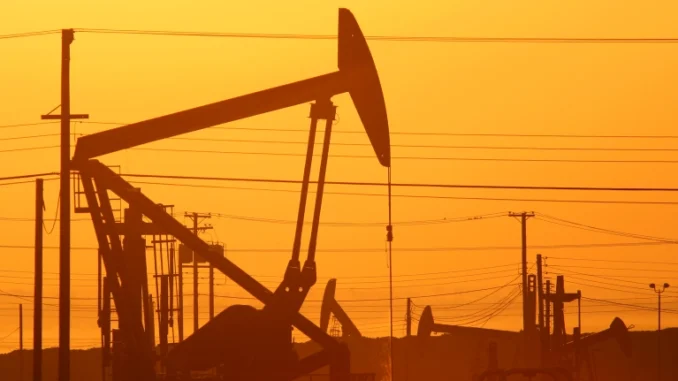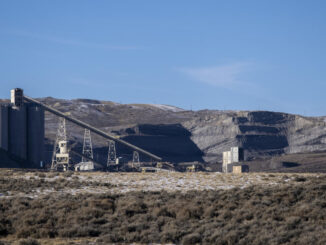
The world’s oil giants had themselves a great year in 2022.
According to recent earnings reports, ExxonMobil made record annual profits, and Chevron saw net profits double — and that’s just the American companies. The bonanza comes against the backdrop of war in Ukraine, which sent energy prices skyrocketing for much of last year.
So, what does that money deluge mean for the climate? For the most part, oil companies are reinvesting it into new oil and gas projects at a time when many governments have signaled a willingness to stick with fossil fuels in the short term. But according to Vijay Vaitheeswaran, Global Energy and Climate Innovation editor at The Economist, there’s another — seemingly contradictory — effect of the current energy crunch: a hastening of the green transition.
“Six months ago, it was not clear which way this picture would go — whether the war would actually make the [climate] picture worse,” Vaitheeswaran said in an interview with Marketplace’s David Brancaccio. “In fact, partly helped by a very mild winter in Europe, there was not an energy tragedy over this winter … getting off of Russian gas has accelerated pretty quickly. And still, Europe has been able to double down on its renewable ambitions in quite a big way.”
The following is an edited transcript of their conversation.

Hosted by David Brancaccio
-
High oil profits and war may actually boost the green transition
Feb 24, 2023
-
Move over Silicon Valley, NYC wants to become the next tech hub
Feb 24, 2023
-
The war in Ukraine, one year on
Feb 24, 2023
David Brancaccio: We’ve been reporting the oil companies did rather well in the year just ended. They did make some serious money, in some cases record profits. What are they doing with this money, just turning it back to shareholders?
Vijay Vaitheeswaran: You’re absolutely right, phenomenal levels of profits at the top five big oil companies, almost $20 billion if we don’t account for one-off reductions for leaving Russia or getting kicked out of Russia. They’re spending it in three ways. The first and most politically controversial, they’re shoveling a lot of that money back to shareholders through share buybacks and special dividends and so on. That is very popular with those shareholders who don’t trust big oil because the oil industry was perhaps the worst-performing industrial sector of the previous decade. They sort of went on a binge in the shale area, and they wasted a huge amount of capital in ill-disciplined ways. And so the shareholders want that money to come back, and particularly the big shareholders and private equity investors are keeping oil bosses pretty tight to the leash. Another way they’re spending the money, though, is probably good news in the short term for energy consumers. And that is they’re investing in oil and gas once again — not as much as they did during the peak days or the boom days — but we did see a supply crunch in the last couple of years, and in part that was because of underinvestment. We have to remember oil and gas is a declining industry. If you do nothing, oil fields decline, and you end up with ultimately no oil at all. And so just to keep the same level of oil pumping, it’s like running up the down escalator — they have to reinvest just to maintain production. So we’re seeing them invest somewhat more into that. The third area is the most interesting, and that is in varying ways on different sides of the Atlantic, they’re investing in the energy transition. That is in renewables or in hydrogen or other kinds of decarbonization, and that’s the one that’s actually the most interesting area where they’re putting their money.
Brancaccio: So the last two actually tug in opposite directions — working to maintain the fossil fuel output while also paying at least some attention to the future of the earth.
Vaitheeswaran: You’re absolutely right. I mean, this is the Gordian knot in which we find ourselves. We both have to keep the trains running and our economy going, which is overwhelmingly reliant on fossil fuels. Something like 80% of global primary energy still relies on fossil fuels today. And that’s 50 years after the first oil shock gave us a warning that we need to get off of oil, and endless cover stories, including ones I remember writing 20 years ago in The Economist, arguing we need to get off of coal. And yet here we are 80% of primary energy, fossil fuels, right. So we can’t stop the world today. On the other hand, we must double down or triple down on investments for tomorrow. So we have to do both.
Brancaccio: Have to do both. And the invasion of Ukraine about a year ago forced, for instance, Europe to rethink its relationship to its energy supplies, because a lot of those relationships had pipelines to Russia. Has what has happened with Russia sanctions and what’s going on in Ukraine pushed Europe closer to green energy? I mean, they were already turning off their nuclear power plants and nuclear power plants are one kind of sustainable source of energy.
Vaitheeswaran: So this is where there’s some good news. Now, six months ago, it was not clear which way this picture would go — whether the war would actually make the picture worse. It might delay the energy transition by some number of years was a concern I certainly had, and we’ve talked about it on your show previously. We saw coal plants come back to life, we saw, of course, the nuclear option off the table for political reasons. The good news is that, in fact, partly helped by a very mild winter in Europe, there was not an energy tragedy over this winter. Granny didn’t freeze, getting off of Russian gas has accelerated pretty quickly. And still, Europe has been able to double down on its renewable ambitions in quite a big way. BP, the oil giant, puts out an annual energy report where they give the world outlook for the next 20-30 years. And then the most recent one, just a few days ago, they argued that the war in Ukraine has actually accelerated the clean energy transition, by their estimation, mainly by reminding the world — not just Europe, but countries like India and China — that reliance on physical fossil fuels sold by authoritarian governments is a dangerous security strategy. And so countries all over the world are actually accelerating in the interest of either energy independence, or certainly energy security, homegrown sources like clean energy and energy storage to support it, rather than just relying on oil and gas from OPEC or from Russia.
Brancaccio: But when you step back a bit, so much of the world’s energy is still from fossil fuels. So that conversion to something more sustainable is a large task. And sometimes, some of the goals set for dealing with climate change can run into the magnitude of the problem that is the massive conversion.
Vaitheeswaran: I agree. And that’s why I think that while it’s an alluring dream, the idea of running the world on windmills and solar power alone, I think realistically, what’s more likely to happen is a transition in which we do still use certain kinds of fossil fuels, but with carbon capture and sequestration, for example, one of the new kinds of climate technologies that’s been championed and advocated by the American legislation and new climate law — the so-called Inflation Reduction Act. Or using ways of converting fossil fuels into clean hydrogen, which can be used in industrial plants rather than burning natural gas. And if we do it the right way — and there are wrong ways to do it, I’m not advocating those — we can see a role in which some fossil fuels, if we combine them with decarbonization, can actually bridge that gap and help us get to that — ultimately — carbon-free future, but I don’t think we can get there in the short term with only the most utopian ideas.



